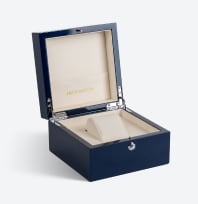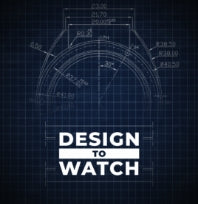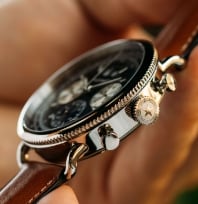The racing watch is not perfect just for the auto enthusiast. With its iconic style and precision, the racing watch has moved from a utility watch to favorite everyday mens watch in record time.
Equipped with a chronograph and tachymeter, the modern racing watch still boasts the same usability as the classic, less polished racing watch. With the modern age, the racing watch has reached new heights in style and is a perfect long-term and ideal investment for any watch collector or novice.
What Makes a Racing Watch
What makes a watch, a racing watch?
Typically they include one or several the following design additions, or in the watch world complications, to the face of the watch. A complication simply means any function that exists on the watch beyond just telling time. Complications could be extra dials, extra hands, or additional bevels.
A great example of a Jack Mason watch with multiple complications is our Mirabeau--it has a three-eye chronograph, tachymeter, and modern twist on a high contrast dial with its beautiful navy blue dial.
Here are the most common complications that make a racing watch:
- High-Contrast Dial: High-contrast dials are easily read at high speeds.
- Chronograph: A separate stopwatch utilizing a start and stop pusher to operate the second hand and has up to three registers on the dial.
- Tachymeter Bezel: A tachymeter bezel scale located around the dial allows the racer to make speed calculation
- Pulsometer Bezel: Measures heart rate
The High Contrast Dial: For Easy Reading
Don’t overthink it. A high contrast dial just means that there’s a high level of contrast between the different components on the face. Typically, though not always, a racing watch will have a very high contrast dial, this is not just a style or design choice, but it is meant to help the user read all the different dials and bezels more efficiently.
The Chronograph: A Stopwatch Function
To recognize a chronograph on your watch, look for the two pushers on either side of your watch crown. A chronograph will also include two additional dials on the face of your watch. One dial is for the minutes and the other, for hours. Typically the minute’s dial is on the right side closest to the buttons, and the hour’s dial is on the left. The chronometer will also have an additional second hand on the main dial of the watch. This second hand is what is used to measure the chronometer rotations around the watch.
To start the chronograph, simply push the top button above the watch’s crown until it clicks. This click starts the additional second hand. To stop the chronograph, simply push the top button again. You will then be able to read your time measurement down to the latter taking the hour and minute dial and second hand into account.
To reset the chronograph, simply press the bottom button. It is best to protect your watch’s inner workings and only to press this bottom button to reset after you have pressed the stop button on the top.
The Tachymeter Bezel: Calculating Speed
A tachymeter bezel is a series of numbers around the outside of the center dial. These numbers start large and close together on the left side of the watch face, and get smaller and usually farther away from each other on the right side of the watch, with 60 being the start at the top of the watch at the 12 o’clock.
The simplest way to describe a tachymeter is that it is used to convert the length of time it takes someone to complete a task into how many times they can complete that task in one hour. This task could be running a mile or kilometers, packing watches into boxes for shipment, or eating hot dogs, so you can predict how many hot dogs one could eat per hour in an eating contest.
To use the tachymeter, first reset your chronograph to the 0, or 12 o’clock, and when you are ready, press the start button. When the task you are measuring is done, click the chronograph button again. Now read the second hand in seconds. This number will be the time it takes you to complete the task.
To read the tachymeter, take note of where the second-hand lines up with the tachymeter numbers on the outside of the dial. This number is the amount of times you will be able to complete that single task in an hour.
- Start chronograph.
- Perform the task.
- Stop chronograph.
- Read numbers on the tachymeter bezel.
Hypothetically, say your tachymeter starts on the 60 at 12 o’clock, has 240 at 3 o’clock, 120 at 6 o’clock, and 80 at 9 o’clock. If you start your chronograph (at 12 o’clock to measure seconds) and run one mile in 30 seconds, you will stop the chronograph at 30 seconds. The tachymeter will tell you that you can run 120 miles in an hour.
- Start chronograph
- A person runs one mile
- Stop chronograph when mile is completed
- Tachymeter bezel shows how many miles the person can run in one hour.
Not all tachymeters have the same measurement units around the outside. Some watches may show slightly different markers, so this example could look somewhat different from watch to watch. However, the tachymeter will still calculate the same units per hour.
The Pulsometer Bezel: Heartbeat Counter
A pulsometer bezel is similar to a tachymeter bezel. The only difference is that it is used to measure heartbeats per minute and uses different measurement units to do so.
However, it is good to note that not all racing watches will have a pulsometer because a person’s pulse is not that important under racing circumstances. Still, some racing watches do have them, because, let’s be honest, most racing watches aren’t used for racing cars these days.
To use the pulsometer to count someone’s pulse:
- Hold your pointer and middle fingers to the person’s wrist.
- Start the chronograph and begin counting the beats in their wrist till you reach 30 and stop the chronograph.
- The number that the second hand has landed on the pulsometer is their heartbeats per minute.
Final Thoughts
Racing watches are an iconic design that is not just for the automobile industry anymore. Racing watches are also worn by runners, swimmers, rowers, doctors, and even manufacturers. However, you don’t have to be in any of these fields to rock a racing watch. Racing watches are just as perfect for the outdoor adventurer as they are for the office’s most stylish man.
The perfect racing watch awaits you. Find your Jack Mason racing style at the finish line here.
Sources:
https://theslenderwrist.com/measure-your-wrist/
https://www.gentlemansgazette.com/driving-racing-watches/
https://www.artofmanliness.com/articles/use-chronograph-tachymeter-wristwatch/









